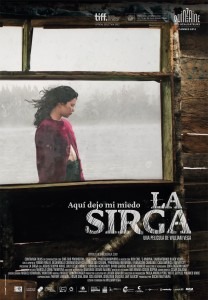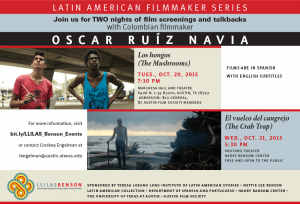 The word «sirga» designates the rope used to bring fishing nets or boats to land. After losing her house and family when unknown armed men burn down her small town, Alicia finds her way to La Sirga, a wrecked hostel run by her uncle on Cocha Lake, located in the southern Colombian Andes, 8800 ft. above sea level. The sirga, the rope, will slowly entice Alicia into the promise of building, maintaining and preparing a lodge for tourists too scared to stray far from Colombia’s major cities. Working at the house signals the unspoken promise for a better future. Surrounded by an immense body of water, the isolated house echoes the tensions that provoked Alicia’s journey to La Cocha in the first place: a silent, anonymous war.
The word «sirga» designates the rope used to bring fishing nets or boats to land. After losing her house and family when unknown armed men burn down her small town, Alicia finds her way to La Sirga, a wrecked hostel run by her uncle on Cocha Lake, located in the southern Colombian Andes, 8800 ft. above sea level. The sirga, the rope, will slowly entice Alicia into the promise of building, maintaining and preparing a lodge for tourists too scared to stray far from Colombia’s major cities. Working at the house signals the unspoken promise for a better future. Surrounded by an immense body of water, the isolated house echoes the tensions that provoked Alicia’s journey to La Cocha in the first place: a silent, anonymous war.
William Vega’s previous short-film Simiente introduced the director to the Cocha landscape, and was produced by Óscar Ruiz Navia, the director of Crab Trap (2009) and Los hongos (2014). This is not a random fact: Vega and Ruiz Navia’s films, along with Ciro Guerra’s The Wind Journeys (2009), Embrace of the Serpent (2014), and César Augusto Acevedo’s Land Shade (2014), among others, can be seen as the corpus of the latest shift in Colombian cinematic narrative. Acclaimed by critics from San Sebastián to Cannes, these prize-winning films have also benefitted from recent Colombian film industry laws. Since 2003, when the Colombian government created legislation fostering investment in the national film industry, more than 130 movies have received grants in different pre-production production and post-production phases. These awards, along with other international grants, have provided filmmakers key access to state-of-the-art technologies. As Vega himself has remarked, the arrival of new film capabilities has coincided with new narrative possibilities: in this series dedicated to contemporary Colombian cinema, we bear witness to such visual explorations.
These new films constitute a departure from previous narratives in a country where war seems to have always existed. Specifically, young Colombian filmmakers like Vega, Ruiz Navia and Guerra distanced their work from representations of drug-related urban violence that had reigned supreme in films, TV series and novels of the previous two decades. Where so-called sicaresca narratives showed noise and chaos, these directors would rather explore the silence of violent everyday life in rural and less well-known areas of Colombia. By doing so, they relocate filmic storytelling on the margins of economic and political power. Thus, the visual repertoire drastically changes: instead of watching city life, we see a giant floating rush sailing against the wind on the lake, like an annunciation. All that we hear and see is the slow pace of the silent waters, and the onset of an impending storm, even though we might not experience the storm itself. We listen to conversations that give us clues that something terrible has happened. We sense that violence is afoot, that something might happen again. Yet like the characters themselves, we are unsure of what is happening now, unsure of what shape violence will take in the present moment.
In La sirga we witness a silent water-and-fire liturgy: these two elements organize all the film’s settings, climate, sound, and human interactions. This silent liturgy is accompanied by extreme care in cinematography and editing, art and sound production. Exceedingly political yet subtle, films like La sirga are designed to immerse their audiences in the present tense, using a keen sense of rhythm, ambient sound and photography to pursue the task of showing what violent life in the margins is like. In a world where we don’t often experience things in the shape of subtle signs, these films can refresh and activate our senses. Films like La sirga might be giving us, as a Colombian film critic once said, the real news of the world.
These are the dates for the Beyond Macondo series, organized by the Austin Film Society, sponsored by the Department of Spanish and Portuguese from the University of Texas at Austin
MATEO
Thu, October 15, 2015, 7:30 PM
LOS HONGOS
Tue, October 20, 2015, 7:30 PM
(The Director of this film, Óscar Ruiz Navia will be present at the screening)

